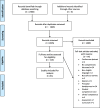Measuring and assessing the competencies of preceptors in health professions: a systematic scoping review
- PMID: 32448239
- PMCID: PMC7247189
- DOI: 10.1186/s12909-020-02082-9
Measuring and assessing the competencies of preceptors in health professions: a systematic scoping review
Abstract
Background: In healthcare, preceptors act as a role model and supervisor, thereby facilitating the socialisation and development of the preceptee into a professional fit to practice. To ensure a consistent approach to every preceptorship experience, preceptor competencies should be measured or assessed to ensure that the desired outcomes are achieved. Defining these would ensure quality management and could inform development of an preceptor competency framework. This review aimed to evaluate the evidence for preceptor competencies and assessment in health professions.
Methods: This study followed the PRISMA ScR scoping review guidelines. A database search was conducted in Embase, Medline, CINAHL and IPA in 2019. Articles were included if they defined criteria for competency, measured or assessed competency, or described performance indicators of preceptors. A modified GRADE CERQual approach and CASP quality assessment were used to appraise identified competencies, performance indicators and confidence in evidence.
Results: Forty one studies identified 17 evidence-based competencies, of which 11 had an associated performance indicator. The competency of preceptors was most commonly measured using a preceptee completed survey (moderate to high confidence as per CERQual), followed by preceptor self-assessment, and peer-assessment. Preceptee outcomes as a measure of preceptor performance had good but limited evidence.
Conclusions: Competencies with defined performance indicators allow for effective measurement and may be modifiable with training. To measure preceptor competency, the preceptor perspective, as well as peer and preceptee assessment is recommended. These findings can provide the basis for a common preceptor competency framework in health professions.
Keywords: Assessment; Competency; Preceptor; Preceptorship.
Conflict of interest statement
The authors declare that they have no competing interests.
Figures
Similar articles
-
Core competencies for Registered Nurse preceptors: A mapping review of quantitative studies.Nurs Open. 2024 Feb;11(2):e2076. doi: 10.1002/nop2.2076. Nurs Open. 2024. PMID: 38375681 Free PMC article. Review.
-
Identifying self-assessed competencies and areas for improvement within community pharmacist-preceptors support during pre-registration training.BMC Med Educ. 2018 Dec 11;18(1):303. doi: 10.1186/s12909-018-1413-x. BMC Med Educ. 2018. PMID: 30537998 Free PMC article.
-
A Preceptor competency framework for pharmacists. Part 2 of a 3-part series.Curr Pharm Teach Learn. 2018 Mar;10(3):402-410. doi: 10.1016/j.cptl.2017.11.018. Epub 2017 Dec 18. Curr Pharm Teach Learn. 2018. PMID: 29764647 Review.
-
National Preceptor Competency Consensus Study.J Nurs Adm. 2025 Jan 1;55(1):14-21. doi: 10.1097/NNA.0000000000001523. Epub 2024 Dec 9. J Nurs Adm. 2025. PMID: 39679685
-
Ensuring the quality of clinical supervision: Stakeholder perceptions of pharmacy preceptor competence.Curr Pharm Teach Learn. 2023 Aug;15(8):722-729. doi: 10.1016/j.cptl.2023.07.003. Epub 2023 Jul 26. Curr Pharm Teach Learn. 2023. PMID: 37500303
Cited by
-
A Cross-Sectional Study on Nursing Preceptors' Perspectives About Preceptorship and Organizational Support.SAGE Open Nurs. 2024 Oct 9;10:23779608241288756. doi: 10.1177/23779608241288756. eCollection 2024 Jan-Dec. SAGE Open Nurs. 2024. PMID: 39484225 Free PMC article.
-
Opening Pandora's box - key facilitators of practice change in detecting and responding to childhood adversity - a practitioner perspective.BMC Pediatr. 2024 Jul 18;24(1):461. doi: 10.1186/s12887-024-04918-5. BMC Pediatr. 2024. PMID: 39026201 Free PMC article.
-
A Competency-based Tool for Resident Evaluation of Pediatric Emergency Department Faculty.West J Emerg Med. 2022 Dec 21;24(1):59-63. doi: 10.5811/westjem.2022.11.57686. West J Emerg Med. 2022. PMID: 36602497 Free PMC article. No abstract available.
-
Increasing Clinician-Scientist Workforce Diversity through the National Institute of General Medical Sciences' Medical Scientist Training Program.ATS Sch. 2022 Sep 7;3(3):358-378. doi: 10.34197/ats-scholar.2022-0018PS. eCollection 2022 Oct. ATS Sch. 2022. PMID: 36312807 Free PMC article.
-
Identification of Core Interprofessional Preceptor Competencies and Development of a Preceptor Self-Assessment Tool.SAGE Open Nurs. 2024 Dec 19;10:23779608241292741. doi: 10.1177/23779608241292741. eCollection 2024 Jan-Dec. SAGE Open Nurs. 2024. PMID: 39711849 Free PMC article.
References
-
- Billay D, Myrick F. Preceptorship: an integrative review of the literature. Nurse Educ Pract. 2008;8(4):258–266. - PubMed
-
- Marriott J, Taylor S, Simpson M, Bull R, Galbraith K, Howarth H, et al. Australian national strategy for pharmacy preceptor education and support. Aust J Rural Health. 2005;13(2):83–90. - PubMed
-
- Mills JE, Francis KL, Bonner A. Mentoring, clinical supervision and preceptoring: clarifying the conceptual definitions for Australian rural nurses. A review of the literature. Rural and remote health. 2005;5(3):410. - PubMed
-
- Woods M. Draft report independent review of accreditation systems within the National Registration and accreditation scheme for health professions. 2017.
-
- Australian Pharmacy Council. Health Profession Accreditation Practices International Literature Review. 2018.
Publication types
MeSH terms
LinkOut - more resources
Full Text Sources
Medical


